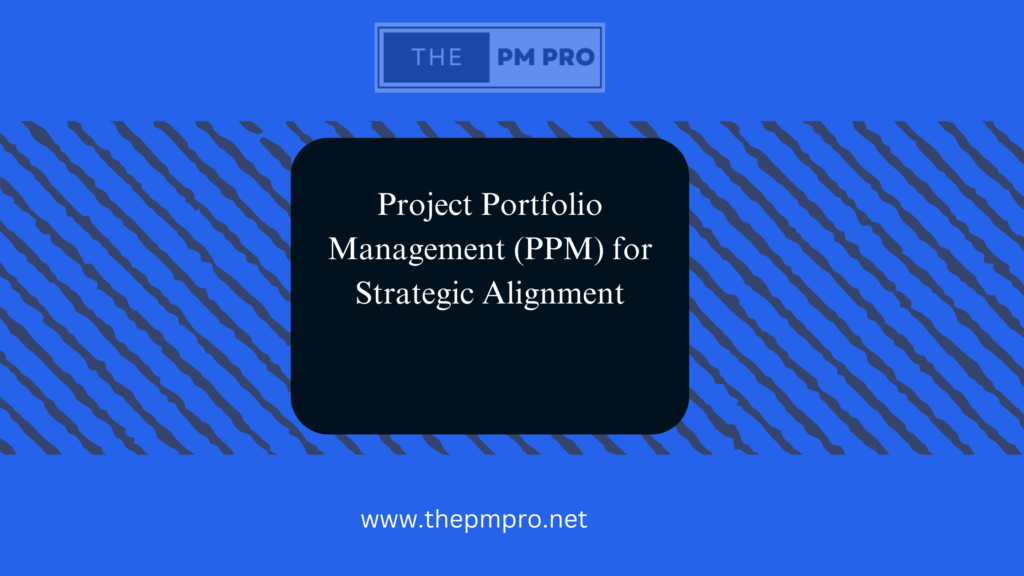Project Portfolio Management Definition
It is the process in which the projects of an organization are evaluated to ensure their strategic alignment with organizational goals. Project portfolio management provides executives and stakeholders with a strategic view of their projects. PPPM groups projects into programs based on similarities and relevance. PPM aligns project management and organizational approach including processes and policies to the goals.

The Benefits of PPM
PPM has the following benefits for organizations:
Big picture thinking and clarity of purpose
PPM enables project managers to execute with details and visualize and understand the way projects, programs, and portfolios relate to mission and vision.
Improved resource management and planning
It highly depends on the way your PMO relates the resource usage to company goals. PPM decreases the wastage and ensures allocation on a priority basis.
Higher productivity
PMOs that communicate the vitality of projects in delivering value increase productivity. Team members who understand their responsibilities to reach strategic goals work harder.
Increased agility
By aligning strategy with activities, organizations become agile, making it convenient to manage change as obstacles arise.
Higher ROI
By facilitating the achievement of clear company objectives, increasing agility and productivity, and improving resource management, PPM increases return on investment for projects.
Project portfolio management software
The use of the right tools is crucial to succeed with PPM. Each tool has features such as portfolio management, dashboard, issue and budget management, status tracking, and task management.
Clarizen
One of the portfolio and project management tools used by larger professional and IT services companies.
Mavenlink
Best for large and small professional services companies, particularly within advertising, marketing, architecture, public relations, engineering, education, and IT services.
Monday.com
A tool for scalable PPM designed for larger teams.
Project Portfolio Management Process Steps
Here are a few key steps for the PPM process:
Identify all potential and existing projects
Without an inventory of upcoming and current projects, it is impossible to develop a robust PPM strategy.
Prioritize each project
Prioritize each project based on order and the reason to execute the project. This will achieve a favorable ROI.
Allocate resources
After the selection and prioritization of projects, resources must be managed. Accurately and carefully assign resources in a way that does not lead to potential conflicts and overloading.
Adjust project strategy when required
It is crucial to revise organizational goals due to the constant nature of change, each project in the programs must ensure alignment with organizational strategy.
PPM Best Practices
Below are some of the key PPM best practices to do PPM the right way:
Identify the best techniques, methods, resources, and technologies
Develop technologies to increase success and conduct a SWOT analysis.
Document everything
Complete documentation saves misinterpretation and misunderstandings.
Communicate things on time
There is no benefit in communicating late or to the wrong people. Ensure to communicate information to the right stakeholders on time.
Key PPM frameworks
Frameworks can affect your PPM execution and strategy. Popular PPM frameworks are:
Agile PPM
Global companies are adopting and recognizing an Agile PPM approach. Some of the Agile PPM benefits are:
- Selection of the right initiatives based on rolling forecast
- Creating and maintaining meaningful oversight
- Higher transparency of resources and work items
- Continuously steering metrics and value in increments
Prince2
Prince2 is developed in the UK and focuses on business cases. Prince2 works in organizations that have a well-defined PMO and where the focus is on project breakdown into stages that are more controllable and manageable.
PMBOK
PMBOK was developed by PMI and is considered the gold standard. PMBOK deploys a knowledge-based approach that relies on the knowledge and experience.
Project Portfolio Management (PPM) for Strategic Alignment- FAQs
How does PPM relate to business strategy?
PPM enables alignment of organizational strategic objectives and project portfolio. It prioritizes projects that align with business strategy; PPM ensures resources are not wasted on less priority projects and projects that have lesser contribution towards achieving overall goals.
What is the value of project portfolio optimization?
The objective of the project portfolio management optimization is to identify and remove from the portfolio, projects with a lesser value and allocate more resources and budget to projects with a high value and that is strategic in nature, or support the major organizational goals.
What is the purpose of project portfolio management?
Project portfolio management sets a method used to predict problems, review progress towards managing budget, and operational goals, and address stakeholder issues, enabling project managers to follow up with precise execution.
What is the goal of strategic alignment?
Strategic alignment aligns the daily activities, objectives, and projects of an organization with its vision. It decreases the gap between execution and strategy.
Do follow our Trending Topics Section for more relevant articles


